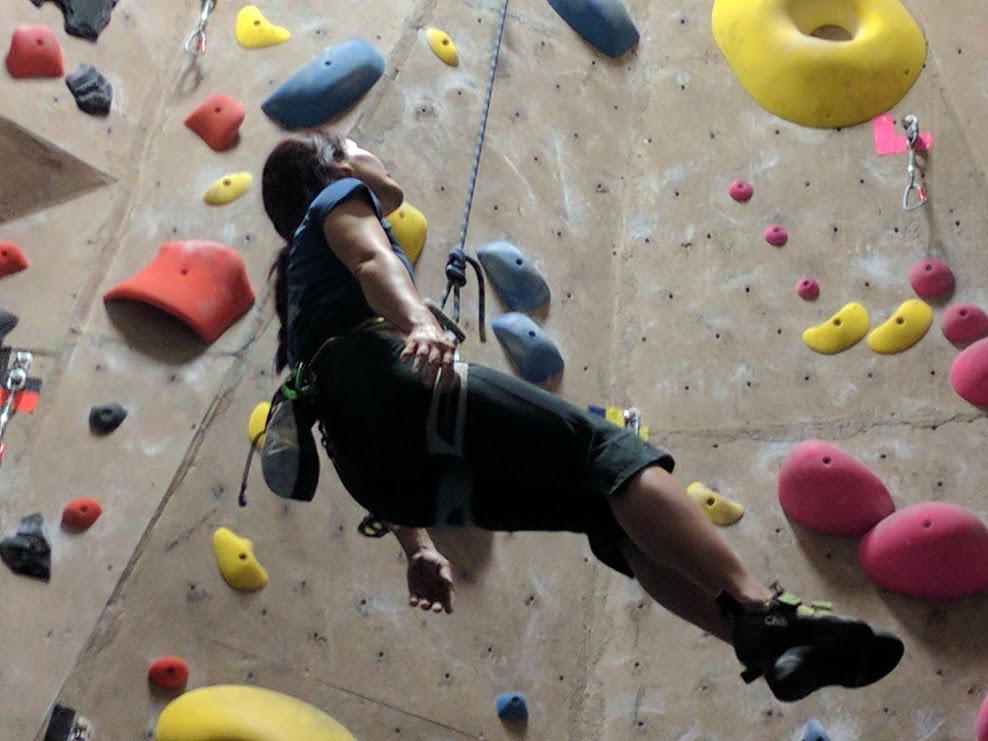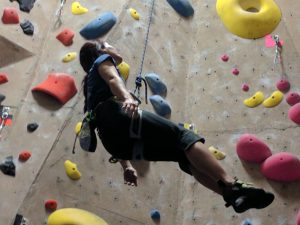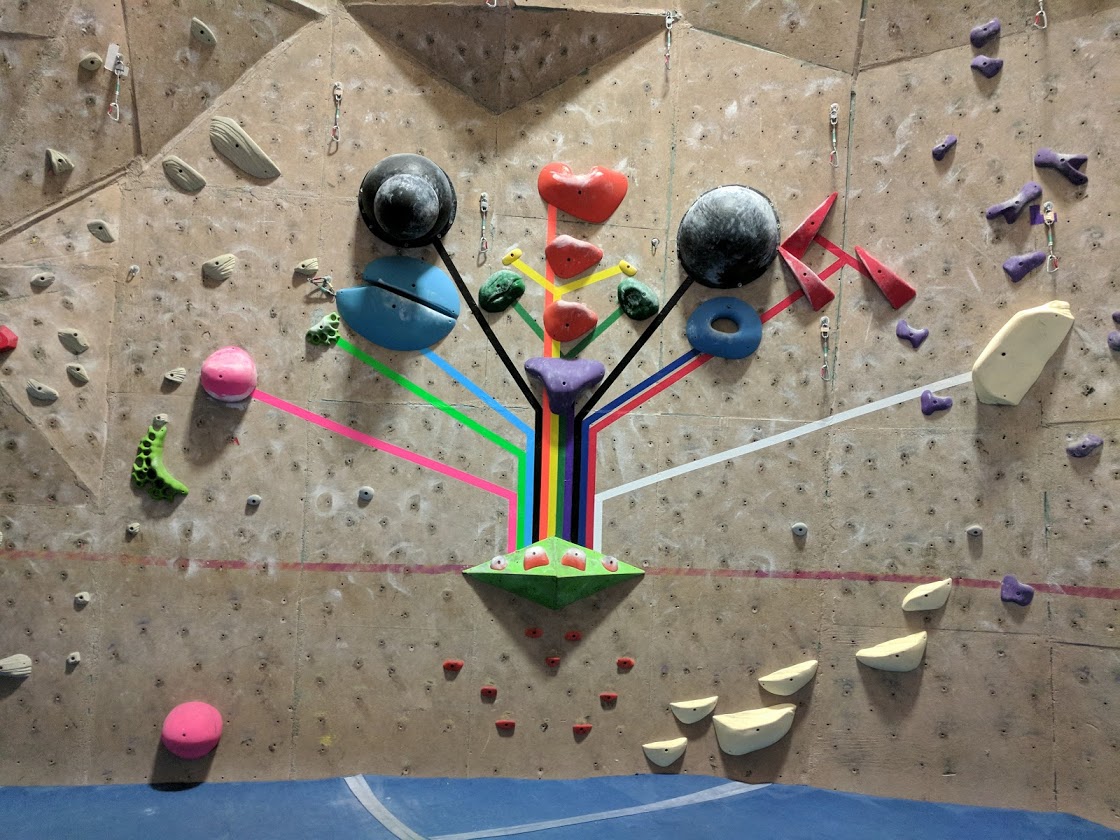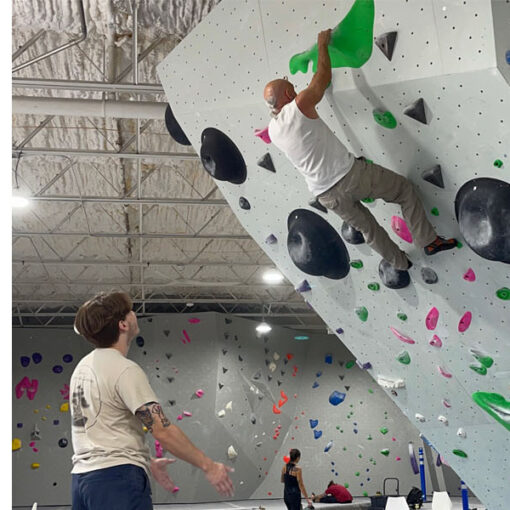
Usually, the first thought that comes to most women’s minds when we are invited to go rock climbing is “My upper body is not strong enough.” However, that is not necessarily all true. Generally, women are more efficient climbers than men because we are not relying only on upper body strength. Also, women’s center of gravity is a little bit lower which is an advantage for better balance. The quad and core are much stronger commonly so women have a natural tendency to employ them first. However, the physical aspect of climbing is the easier part of the climbing. It’s the mental aspect that stops us shortly before the physical strength is even engaged.
In this article, I will discuss seven strategies and tips on how to overcome the fear of falling in the sport of rock climbing as a beginner. Similar to many other sports, physical and mental strengths are required in rock climbing. As you climb more, you may want to climb harder routes to challenge yourself and sometimes fear can prevent you from taking yourself up to the next level.

In rock climbing, the fear of falling is the most common next to the fear of height. Your mind and body are amazing. Based on scientific research, we use only a small percentage of our minds. Imagine what we can accomplish if we are able to use more than 50% of our brains at all times.
Just like lifting weights to gain strength for the body, it does not hurt to train the muscles of the mind as well. Once you start climbing, you will notice the body will also gain muscle memory on its own. Here are the seven tips to practice in training your mind:
-
Differentiate between real fear and irrational fear

Irrational fear – your own shadow It is hard to differentiate between what is real and what is irrational when you are in the midst of your fear. Your mind has a tendency to think about the worst-case scenario. Once you go there, the fear snowballs and continues to confirm your fear with a more imaginary scenario of more and more possible and horrible outcomes even before you leave the ground and start climbing.
What would be the worst-case scenario that could happen when you climb in an indoor gym? You would slip, and fall, and your belayer would catch you with the rope you are attached to.
Before you even start, it is good to be aware of where you are and clear your mind of any “what ifs” scenarios. Acknowledge that you are safe and in good hands with your partner.
-
Practice falling & learn how to fall

Practice falling You have heard the cliche “Practice makes perfect”. The same goes for practice falling. Have a partner work with you in practice falling by adding slack to your rope line. The more you practice the better you become and more confidence will build. Your mind will acknowledge that you are safe. First practice and plan the fall with your partner. Once you are comfortable with planned falls, try to spontaneously fall without announcing it to your partner.
When practicing falling, relax the body and push yourself away from the rocks if possible. Also, make sure to stay clear of the rope around your feet or hands. You don’t want anything to get caught in the rope which could cause rope burn or a snag that could cause you to go upside down, sideways, or any other weird positions.
-
Positive self-talk
It is normal for you to be afraid. It’s the most natural aspect of your emotions. It is what keeps us safe from harm. Respect that fear and be aware of it. The important thing to notice is what are you going to do in the face of that fear. Instead of going against your fear or even trying to stop it, soothe it with positive reinforcement comments to relax your mind.
“It’s so high. I am not sure I can reach it. I am not strong enough.” You can soothe again by substituting “I can do this. I am sure that there is another way. How can I use my feet to help me reach and shift my weight over so that I won’t rely all on my arms to lift me up?”
“That hold is too small. My feet or hands can not grab hold of it. I am not good enough.” You can substitute and soothe yourself by saying “It is a good time to practice my fall. I can hang and relax a little bit.”
These are a few examples of different possible scenarios. Again practice soothing your mind as soon as a negative thought pops into your head. “Practice makes perfect.”
-
Visualization
Visualization is the practice of climbing sequences mentally in your mind. The subconscious does not differentiate between reality and imagination. The goal is to view a perfect movie of your climbing motion ascending to the top as real as you can make with your mind. The more realistic it feels the more believable it will be for your mind. Feel the texture against your hands and feet. What does it smell like around you? What do you hear while you are climbing? See yourself ascend to the top with perfect style and self-confidence.
Visualization enhances the learning process and prepares you with the feeling of confidence to confirm with your mind. There are many examples of experiments with talented athletes years ago where there were groups who focused on visualization versus groups who didn’t visualize themselves playing their sport. The visualized groups showed a greater percentage of improvements over those who were not.
I found a great article called “The Effect of Visualization, Relaxation, and Self-efficacy on the Performance of Men Speed World Record Athletes Category.” It was submitted by the Faculty of Sport Sciences, Yogyakarta State University, Yogyakarta, Indonesia.
-
Breathe
When we are in a nervous or scary situation, we normally hold our breath and hope for the best. Do you find yourself running out of breath as you reach the top of your climb? Do you hold your breath and don’t realize it? In a challenging rock climbing situation, it is helpful to remember to breathe. Take a long deep breath in and blow it out as you ascend up the next hold. Breathing also helps prolong our stamina when the route is longer than usual as well as lowers our heart rate and calms our brain.
-
Self-check and partner-check
Check your gear and your knot. Make sure the figure-eight knot is in place and tied into your harness. Check that there are no loose ends hanging out of place on your harness and the rope. Check your partner’s belay device and make sure the rope

Figure-eight knot loops properly through their belay and their harness.
Checking yourself and your partner is a good and helpful habit. It is good confirmation to know that you have working equipment and an excellent belayer.
-
Focus and clear your mind
The key to focus is to clear your mind from “what ifs”. Spend ten to fifteen minutes before your rock climbing session and work on breathing exercises to help clear the mind from any negative thoughts and just focus only on your breaths.
When you start climbing, focus on the route, take one step at a time, and climb up. Only look up toward where you want to go. Focus on finding the handhold, then the foothold, then move up to the next hold, and so on and so forth.
For some people, they may want to focus on a conversation with the belayer to distract them from thinking negative thoughts. The conversation could be as simple as rock climbing commands “climbing” or “slack” (to give more rope) or “take” (to tighten the rope), etc.
We are what we think we are so fulfill our own expectations with a positive outcome instead of focusing on the negative outcome. It is almost like a self-fulfilling prophecy. If you feel that you are going to fall, fall. You know that your belayer will catch you. You have self-checked and you have partner-checked. Breathe and practice that fall again and again until you feel comfortable falling.
Believe in yourself and believe you can do it. Experience life to the fullest and do what you love most. Climb on my friends.
I love to hear from your perspective of the fear of falling. Please leave your comment below.









12 thoughts on “How to Overcome Fear of Falling – Seven Tips for Beginning Climbers”
I have always wanted to try rock climbing. Your advice in this post is wonderful! I had never thought of practicing falling. That part in particular was brilliant to me. The other points are great as well but I had never thought about how useful it could be to practice a fall so that you know how that would feel and what the results would be. Maybe I could talk my husband into trying it now! Thanks for sharing!
You’re welcome and thank you for your comment. It does release a lot of anxiety after your first practice fall. I enjoy and appreciate my husband tremendously for spending the time to be with me. He’s awesome.
Informative and motivational overcoming the fear of falling is a biggie.
Very well written the Positive self-talk, Visualization, and Focus and clear your mind
is great.
Thank you! They are continuously great reminders for me every time I climb.
I tried rock climbing about 15 years ago at an indoor club and I really wish i would have had an article like this to read back then. I think I would have kept at it and found a better way to focus on climbing upward instead or wondering ‘when am I going to fall?’. Do you find it helpful to start in an indoor club then progress to the smaller cliffs? I ask because my kids have shown interest in rock climbing. Thanks.
Thank you for your comment. Yes, absolutely helpful to start in an indoor club then progress to the small cliffs. This is how I started. Unless you have a knowledgeable guide for the outdoor environment that could be as much fun. The guide will provide everything you need for climbing outdoor. However it could be more expensive than to try out the indoor route first. Kids are really fast learner and they are strong. They do not have all the years of the fear experience built in. Have a fun time. I know he’ll enjoy it.
You have some great information there. Personally I have never even tried climbing. I always look in awe at those that do climb. I am concerned about the falling part but you have some good ideas to maybe get me on that wall. Thanks for the info.
You’re welcome Bill and thank you for your comment. I would never thought to try climbing until my son joined the rock climbing team. I climbed once more than 25 years ago. I had fun but that was a one time thing. Now it becomes a sport that I truly enjoy.
My little sister has been telling me that she wants to take up rock climbing, this is the perfect post for me to share with her!
I’ve been rock climbing once before with some experienced friends, and I can definitely relate to the fear aspect of rock climbing. Even when you have those ropes secured, it’s still a little scary as you’re making your way to the top.
I guess the human mind will always try to protect itself by telling you not to do things that you’re not used to like rock climbing, but that visualization technique may be the secret to convincing your mind that rock climbing it totally normal and natural for you!
Thank you Nick for your comment. It’s like learning Japanese or any foreign languages. Immerse your brain with possibilities. I know your sister will enjoy it. It is a fun and social sport.
Ha,
Thanks for posting this! I have always wanted to try rock climbing but never had the courage to try (I would otherwise characterize myself as a very courageous person). If I get invited to go, I’ll definitely read this post again before going!
Thanks,
Emily
Thank you, Emily for your comment. If you are ever visiting Orlando, please let me know and we can climb together. I am sure you’ll be a natural climber.